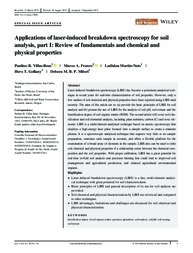Applications of laser-induced breakdown spectroscopy for soil analysis, part I: Review of fundamentals and chemical and physical properties.
Applications of laser-induced breakdown spectroscopy for soil analysis, part I: Review of fundamentals and chemical and physical properties.
Author(s): VILLAS-BOAS, P. R.; FRANCO, M. A.; MARTIN NETO, L.; GOLLANY, H. T.; MILORI, D. M. B. P.
Summary: Laser-induced breakdown spectroscopy (LIBS) has become a prominent analytical technique in recent years for real-time characterization of soil properties. However, only a few studies of soil chemical and physical properties have been reported using LIBS until recently. The aims of this article are to: (a) provide the basic principles of LIBS for soil analysis and (b) present the use of LIBS for the analysis of soil pH, soil texture and the humification degree of soil organic matter (SOM). The second article will cover soil classification and soil elemental analysis, including plant nutrients, carbon (C) and toxic elements. LIBS is a multi-element analytical technique based on atomic spectroscopy that employs a high-energy laser pulse focused onto a sample surface to create a transient plasma. It is a spectroscopic analytical technique that requires very little or no sample preparation, examines each sample in seconds, and offers a flexible platform for the examination of a broad array of elements in the sample. LIBS also can be used to infer soil chemical and physical properties if a relationship exists between the chemical composition and the soil properties. With proper calibration, LIBS has a great potential for real-time in-field soil analysis and precision farming that could lead to improved soil management and agricultural production, and reduced agricultural environmental impacts.
Publication year: 2019
Types of publication: Journal article
Unit: Embrapa Instrumentation
Observation
Some of Embrapa's publications are published as ePub files. To read them, use or download one of the following free software options to your computer or mobile device. Android: Google Play Books; IOS: iBooks; Windows and Linux: Calibre.
Access other publications
Access the Agricultural Research Database (BDPA) to consult Embrapa's full library collection and records.
Visit Embrapa Bookstore to purchase books and other publications sold by Embrapa.

